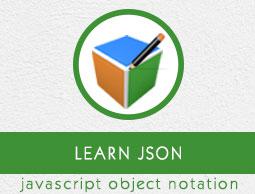JSON - DataTypes
JSON format supports the following data types −
| Sr.No. |
Type & Description |
| 1 |
Number
double- precision floating-point format in JavaScript |
| 2 |
String
double-quoted Unicode with backslash escaping |
| 3 |
Boolean
true or false |
| 4 |
Array
an ordered sequence of values |
| 5 |
Value
it can be a string, a number, true or false, null etc |
| 6 |
Object
an unordered collection of key:value pairs |
| 7 |
Whitespace
can be used between any pair of tokens |
| 8 |
null
empty
|
Number
It is a double precision floating-point format in JavaScript and it depends on implementation.
Octal and hexadecimal formats are not used.
No NaN or Infinity is used in Number.
The following table shows the number types −
| Sr.No. |
Type & Description |
| 1 |
Integer
Digits 1-9, 0 and positive or negative
|
| 2 |
Fraction
Fractions like .3, .9
|
| 3 |
Exponent
Exponent like e, e+, e-, E, E+, E-
|
Syntax
var json-object-name = { string : number_value, .......}
Example
Example showing Number Datatype, value should not be quoted −
var obj = {marks: 97}
String
The table shows various special characters that you can use in strings of a JSON document −
| Sr.No. |
Type & Description |
| 1 |
"
double quotation
|
| 2 |
\
backslash
|
| 3 |
/
forward slash
|
| 4 |
b
backspace
|
| 5 |
f
form feed
|
| 6 |
n
new line
|
| 7 |
r
carriage return
|
| 8 |
t
horizontal tab
|
| 9 |
u
four hexadecimal digits
|
Syntax
var json-object-name = { string : "string value", .......}
Example
Example showing String Datatype −
var obj = {name: 'Amit'}
Boolean
It includes true or false values.
Syntax
var json-object-name = { string : true/false, .......}
Example
var obj = {name: 'Amit', marks: 97, distinction: true}
Array
It is an ordered collection of values.
These are enclosed in square brackets which means that array begins with .[. and ends with .]..
The values are separated by , (comma).
Array indexing can be started at 0 or 1.
Arrays should be used when the key names are sequential integers.
Syntax
[ value, .......]
Example
Example showing array containing multiple objects −
{
"books": [
{ "language":"Java" , "edition":"second" },
{ "language":"C++" , "lastName":"fifth" },
{ "language":"C" , "lastName":"third" }
]
}
Object
It is an unordered set of name/value pairs.
Objects are enclosed in curly braces that is, it starts with '{' and ends with '}'.
Each name is followed by ':'(colon) and the key/value pairs are separated by , (comma).
The keys must be strings and should be different from each other.
Objects should be used when the key names are arbitrary strings.
Syntax
{ string : value, .......}
Example
Example showing Object −
{
"id": "011A",
"language": "JAVA",
"price": 500,
}
Whitespace
It can be inserted between any pair of tokens. It can be added to make a code more readable. Example shows declaration with and without whitespace −
Syntax
{string:" ",....}
Example
var obj1 = {"name": "Sachin Tendulkar"}
var obj2 = {"name": "SauravGanguly"}
null
It means empty type.
Syntax
null
Example
var i = null;
if(i == 1) {
document.write("<h1>value is 1</h1>");
} else {
document.write("<h1>value is null</h1>");
}
JSON Value
It includes −
- number (integer or floating point)
- string
- boolean
- array
- object
- null
Syntax
String | Number | Object | Array | TRUE | FALSE | NULL
Example
var i = 1;
var j = "sachin";
var k = null;


